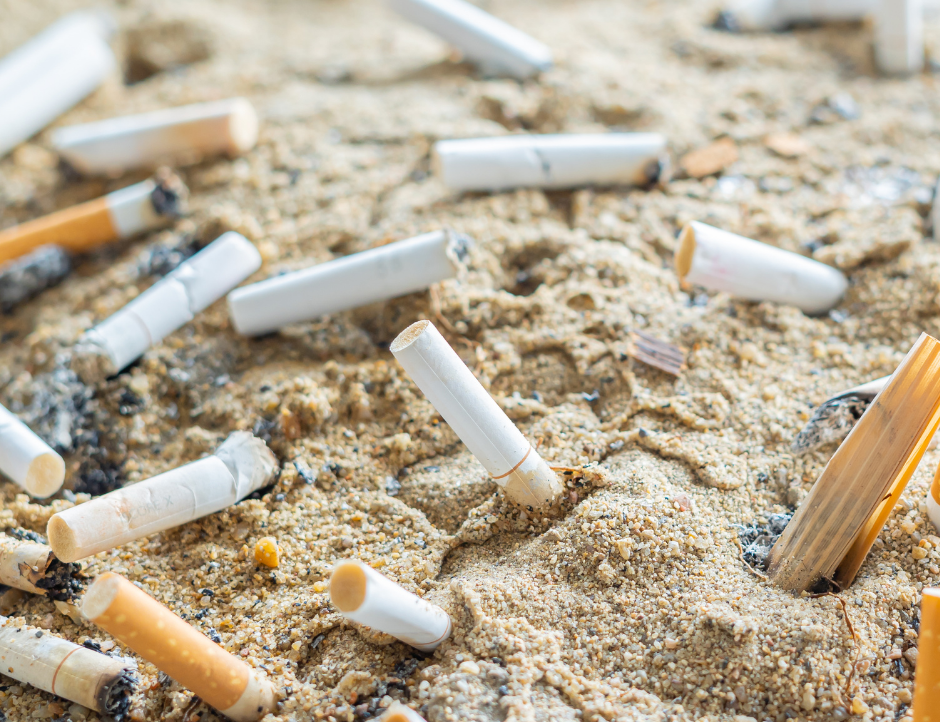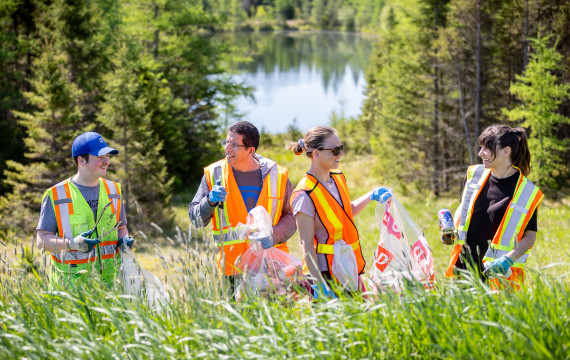Improperly Discarded Cigarette Butts and Their Effect on the Environment
Divert NS Sponsor a Student Intern Series
Each year, Divert NS provides a bursary and work placement opportunity to a NSCC student in the Natural Resources Environmental Technology or Environmental Engineering Technology programs. This year’s recipient is Sarah Ingraham, who is completing her second year in the Environmental Engineering Technology program. As part of his internship, Sarah will be a contributing WNN reporter, reporting on areas of waste management that are important to her.
Divert NS, in conjunction with Dillon Consulting, conducted a roadside litter audit in 2021. The results of the audit found that cigarette butts and debris were the most common small litter item found under 25cm2. Cigarette butts are not just found along Nova Scotia roadways; Oceanwise has found cigarette butts to be the most littered items in shoreline cleanups across Canada, and the Great NS Pick Me Up routinely identifies butts as one of the most common items found during their volunteer cleanups across Nova Scotia. Cigarette butts have also been found to be the most common litter in the world.
We all know about the negative health effects of smoking cigarettes, but have you ever wondered about the effect of improperly disposed cigarette waste on the environment? In addition to being one of the most common causes of unintended fires, improperly disposed of cigarette butts also cause persistent environmental degradation. Although the effects of one cigarette butt may seem small, the fact that they are one of the most littered items makes this a big issue.
A cigarette butt is composed of four main parts. The filter, tobacco, ash, and paper wrapping. Pollutants can originate from the materials themselves and can also be formed as biproducts of tobacco combustion.

Components of a Cigarette Butt
- Tobacco Residue:
- Material: Unburned tobacco at the end of the cigarette
- Impact:
- Nicotine: Highly toxic to aquatic organisms.
- Pesticides: Tobacco is often treated with pesticides during the growing process as well as during storage.
- Ash
- Material: Burned tobacco material
- Impact:
- Polycyclic Aromatic Hydrocarbons (PAH’s), formaldehyde, and cyanide and polynium-210 are formed during the combustion process.
- Contains heavy metals such as cadmium, lead, and arsenic.
- Paper Wrap
- Material: Treated paper which includes bleaches, glues, and burn additives
- Impact
- Bleaching may be toxic to the environment if chlorine is used as the bleaching agent. Luckily, calcium carbonate is increasingly being used due to health concerns.
- May contain chemicals that resist decomposition.
- Filter
- Material: Cellulose acetate: Plastic fiber that looks and feels like cotton
- Impact:
- Cellulose acetate is very slow to degrade and contributes to microplastic pollution.
- During the smoking process, the heavy metals and pollutants and combustion biproducts from all parts of the cigarette accumulate in the filter.
These substances don’t stay locked within the material. When discarded, cigarette butts leach chemicals and metals into soil and waterways, especially during rainfall or flooding. A study from 2020 found that water concentrations of 5 butts per liter resulted in a 60-100% mortality of freshwater invertebrates within 5 days (Dannielle Senga Green, 2020).
Many of these chemicals are also persistent and bioaccumulate through our food and water systems. Exposure to these toxins can increase rates of cancer and other forms of disease.
Nova Scotia is abundant in freshwater resources and our water systems are highly integrated. Because of this, contamination in our waterways can spread over far distances relatively quickly. Since cigarette litter can be found in a wide range of locations, this can lead to widespread contamination over time.
Cigarette litter is a challenging issue, and there is not always a receptacle nearby for every smoking situation. However, there are a few solutions out there.
Pocket Ashtray: Designed to lock in odors and can be reused.
Butt Bucket: Enjoy having a cigarette with your drive. Try a Butt Bucket which is designed to fit in your car cupholder.
If you want to go one step further than simply discarding cigarette waste into a receptacle, there is now a company called TerraCycle that recycles cigarette butts and turns them into new products. Simply ship your butts to their warehouse free of charge.
Every improperly discarded cigarette butt contributes to the toxic degradation of the environment. What seems like a small insignificant act of flicking a cigarette butt on the ground or out the window is, in reality, contributing to toxic waterways, is harmful to ecosystems and wildlife, and contributes to microplastic pollution. By choosing proper cigarette disposal, we take a simple yet powerful step to protect and preserve our soil and water for generations to come.
References
Andrew Turner, A. L. (2024, February). Cigarette filter fibres as a source and sink of trace metals in coastal waters. Retrieved from Science Direct: https://www.sciencedirect.com/science/article/pii/S0045653523031156
Dannielle Senga Green, L. K. (2020, November). Smoked cigarette butt leachate impacts survival and behaviour of freshwater invertebrates. Retrieved from Science Direct: https://www.sciencedirect.com/science/article/abs/pii/S0269749120359741?via%3Dihub
Elli Slaughter, R. M. (2011, November 1). Toxicity of cigarette butts, and their chemical components, to marine and freshwater fish. Retrieved from BMJ Journals: https://tobaccocontrol.bmj.com/content/20/Suppl_1/i25
Jessica M. Rath, R. A. (2012). Cigarette Litter: Smoker's Attitudes and Behaviors". Retrieved from MDPI: https://www.mdpi.com/1660-4601/9/6/2189
Len Garis, C. B. (2019, March). Fires in Canada Originating from Smoking Materials. Retrieved from University of Fraser Valley: https://cjr.ufv.ca/wp-content/uploads/2019/03/Fires-in-Canada-Originating-from-Smoking-Materials-March-2019.pdf
Mehrdad Ghasemi, T. F. (2024, April 09). The fate of leaked heavy metals in the urban environment under different persistence and precipitation scenarios. Retrieved from Nature: https://www.nature.com/articles/s41598-024-59057-9


